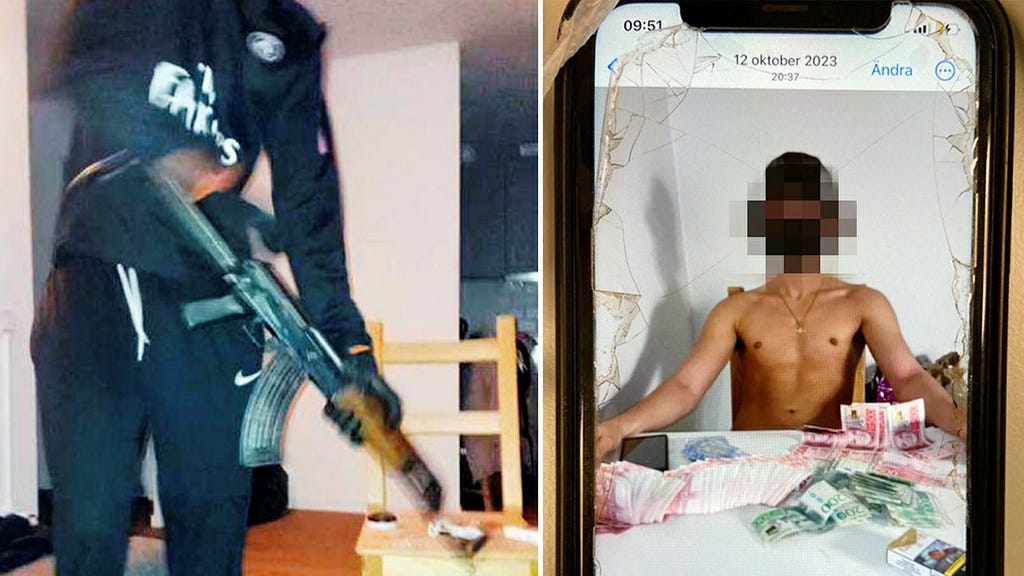In the autumn of 2023, a wave of violence culminating in three ruthless murders shocked the Stockholm area. The first incident occurred shortly after midnight on October 12th, when a 40-year-old father was shot dead in his Västberga villa. His wife, holding their two-year-old daughter, was critically injured after being shot twice in the back. The child also sustained gunshot wounds. Approximately 25 hours later, a 60-year-old grandmother and her 20-year-old foster daughter were killed in their Tullinge home while three other children were present. The perpetrator in both attacks was a 16-year-old boy wielding a Kalashnikov assault rifle, acting on orders from a 15-year-old boy. This series of events sparked widespread fear and outrage, highlighting the escalating violence involving young individuals in the region.
The Södertörn District Court handed down historically harsh sentences to the two teenagers in late August. The 16-year-old shooter received a 12-year prison sentence for three counts of murder, marking the harshest penalty ever imposed on a minor in Sweden. The 15-year-old who orchestrated the attacks was sentenced to 10 years for multiple offenses, including three counts of instigating murder, making him the youngest individual in modern Swedish legal history to receive a prison sentence of this magnitude. The unprecedented severity of the sentences underscored the court’s determination to address the alarming trend of youth violence and hold perpetrators accountable, even at a young age.
The Svea Court of Appeal upheld the lower court’s assessment of the crimes’ severity but slightly reduced the sentences due to the time the boys spent in pre-trial detention under restrictive conditions. The instigator’s sentence was reduced to nine years and ten months, while the shooter’s sentence was lowered to eleven years and ten months. Despite the reduction, the Court of Appeal emphasized the exceptional gravity of the offenses, marked by a complete disregard for human life. The court’s decision reflected the challenging balance between acknowledging the perpetrators’ youth and the need for just punishment for extraordinarily violent acts. The case also ignited debate about the effectiveness of the Swedish juvenile justice system and the potential impact of societal pressures on sentencing practices.
The brutal nature of the crimes shocked even seasoned law enforcement officers. The crime scene in Tullinge was described as a war zone, and the presiding judge noted the unprecedented brutality of the acts, emphasizing the absence of any mitigating circumstances. The court determined that the combined sentencing value for the attacks, even at a conservative estimate, amounted to 50 years imprisonment for the instigator, considered a highly dangerous individual. This figure was higher than the shooter’s due to his role in initiating the violence. However, due to the instigator’s age, the sentence was significantly reduced in accordance with established legal principles for juvenile offenders. Similarly, the shooter’s combined sentencing value of 48 years was reduced based on his age.
The case also involved two other individuals. A 16-year-old girl received a closed youth care sentence for aiding and abetting murder, while a 22-year-old man initially received a 16-year prison sentence for similar charges. However, the Court of Appeal acquitted the 22-year-old man, citing insufficient evidence to prove his intent to commit the crimes. The girl’s sentence was reduced by two months. The triple murders were linked to the ongoing feud within the Foxtrot criminal network, a conflict between former allies turned rivals Rawa Majid and Ismail Abdo. However, none of the victims had any apparent connection to the gang war. One theory suggests that the family in Västberga was targeted due to sharing a surname with a notorious gang member, highlighting the indiscriminate nature of the violence and the potential for tragic consequences arising from mistaken identity. The individual or individuals who commissioned the murders are believed to be outside Sweden, further complicating the pursuit of justice.
The case sparked significant public discussion about youth crime, sentencing guidelines for minors, and the influence of gang violence on Swedish society. The court’s decision to impose lengthy prison sentences, even on young offenders, signaled a potential shift in judicial approach towards prioritizing public safety and accountability over rehabilitation in cases of extreme violence. The tragic events of autumn 2023 served as a stark reminder of the devastating impact of gang conflicts and the urgent need for comprehensive strategies to address the root causes of youth involvement in criminal activities. The fact that the individuals who ordered the hits were likely abroad also highlighted the transnational nature of organized crime and the challenges in holding all those responsible accountable.














